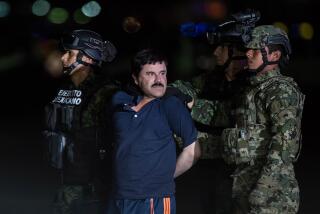Nicaragua Gets More Soviet Arms : Copters, Missiles Boost Arsenal for War With Contras
- Share via
MANAGUA, Nicaragua — In preparation for a stepped-up war with the U.S.-backed contras, the Nicaraguan government has received large shipments of military hardware in recent weeks, including several Soviet-made helicopter gunships, according to military and diplomatic sources.
The sources, who asked not to be identified, said the shipments included six to eight new Soviet MI-24 assault helicopters, which would double the number of these gunships in the Sandinista fleet. The Sandinistas also have acquired new surface-to-air missiles that are more sophisticated than any they previously have had, one analyst said.
As the contras fighting the leftist Sandinista government begin to receive $100 million in U.S. funds, “the Soviets have definitely upped the ante” by stepping up weapons deliveries to the Sandinistas, said a Western diplomat who asked not to be identified.
Contras to Train in U.S.
President Reagan last Friday released $100 million in aid to the Nicaraguan rebels, called contras , and put the program back under the control of the CIA, ending a two-year congressional prohibition on direct CIA involvement in the war.
The contras, who also will receive portable surface-to-air missiles, are expected to begin receiving U.S. training in guerrilla warfare soon.
Military observers say the Sandinistas most likely will showcase their new acquisitions in a military parade and air show at the Nov. 8 celebration of the 25th anniversary of the founding of the Sandinista National Liberation Front. The Sandinistas have been in power here since the 1979 revolution that overthrew the government of Anastasio Somoza.
Soviet Ships Arrive
Two Soviet ships bearing new arms for the Sandinistas arrived last week at the port of Corinto, on the northern Pacific coast of Nicaragua, sources said. Other shipments are believed to have been delivered more than a month ago.
Sandinista Popular Army officials could not be reached for comment on the reports. The Sandinistas normally refuse to discuss military deliveries or the size of their air force, which they consider to be military secrets.
Military analysts put the total number of helicopters in the Sandinista fleet at between 40 and 50. The Sandinistas have about 22 MI-8 and MI-17 transport helicopters, about half of which arrived last spring. They also are believed to have had six or eight MI-24s before the latest delivery.
The transport helicopters give the Sandinistas rapid troop mobility, and the gunships deter the contras from massing in groups large enough to launch a major attack.
In Washington, a U.S. State Department source confirmed an intelligence report of the arrival of six new MI-24s that “effectively doubled” the Sandinista fleet of gunships. The helicopters were detected last week.
“It seems like a solid report,” he said.
The MI-24s, with a maximum speed of 199 m.p.h, are armed with machine guns, anti-tank missiles and rocket pods. The MI-24s are difficult to shoot down because of their speed and their electronic defenses against heat-seeking missiles.
Transport Plane Downed
Analysts here said the Sandinistas also have received SA-3 heat-seeking missiles, a less-portable but more powerful missile than the one used earlier this month to shoot down an American-piloted contra supply plane.
On Oct. 5, a Sandinista soldier downed a C-123 transport plane, killing two Americans and an unidentified Nicaraguan. A third American, Eugene Hasenfus, was captured and remains in custody here, charged with terrorism, violation of the law on public order and security and illicit association for criminal purposes.
That plane was shot down with a portable SA-7 heat-seeking missile, which has a range of about 1.8 miles. The SA-3, which arrived more than a month ago, has a range of about twice that. The SA-7 is shoulder-fired while the SA-3 is mounted on a trailer.
The sources could not confirm the number of SA-3s that have arrived. One analyst said they arrived more than a month ago and were being stored in Sebaco, in the central province of Matagalpa.
Puerto Rico Training Site
While analysts term the arrival of the new weapons an escalation of the war, they said the deliveries were an anticipated response to the $100 million in aid to the contras.
Meanwhile, in Washington, U.S. officials confirmed that they plan to train Nicaraguan rebel officers at military bases in the United States and Puerto Rico.
The Reagan Administration initially planned to send U.S. Army Special Forces to train the contras in Honduras, where the rebels’ largest camps are located. But the governments of Honduras, Costa Rica and El Salvador all objected to hosting the training, “so it’s not going to be in Central America,” a State Department official said.
The training, which was endorsed by Congress when it approved the $100 million in aid for the rebels this year, will be aimed at rebel unit commanders, not ordinary troops.
“Part of the idea is to reduce the political fallout from the training,” one official said. “So it’s not going to be in downtown Los Angeles or anyplace else where it would draw a lot of protesters. And if people do find it, we’ll just move it somewhere else.”
Have Some Missiles
The contras have 12 airplanes and two helicopters of their own based in Honduras but are expecting to upgrade their air fleet with the new aid. So far they have only used the aircraft for reconnaissance, resupply and medical evacuation, but they hope to outfit some of the planes with machine guns to attack Sandinista ground units.
The contras also have a few SA-7s and have been told that they will receive more under the military aid package. They’re negotiating with the Reagan Administration for more powerful missiles.
The contras are known to have knocked down one Sandinista transport helicopter last December. Military analysts say the Sandinistas have lost two transport helicopters and a C-47 cargo aircraft this year, but say they believe the Sandinistas accidentally shot down one helicopter and the airplane themselves. The other helicopter crashed because of mechanical failure.
Pilots Error Cited
“It appears they have problems with land-to-air communications,” said a Western diplomat.
Another said it is difficult to distinguish between enemy and friendly aircraft from the ground and also blamed inexperienced Sandinista pilots for entering free-fire air routes.
Sources said that hundreds of military transport trucks also have arrived in Nicaragua in the last few months. One source said he saw a convoy of four Soviet GAZ trucks headed for Managua from Corinto Port last week.
“They were new, without plates,” the source said.
Previously the Sandinistas have relied primarily on East German IFA trucks.
Another source said that early Sunday he saw a convoy of 14 trucks carrying crates moving through the central province of Chontales East, toward the province of Zelaya--areas where the contras are expected to expand their fighting in the coming months.
Times staff writer Doyle McManus in Washington also contributed to this story.
More to Read
Sign up for Essential California
The most important California stories and recommendations in your inbox every morning.
You may occasionally receive promotional content from the Los Angeles Times.










